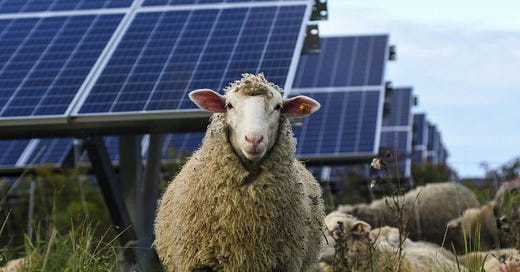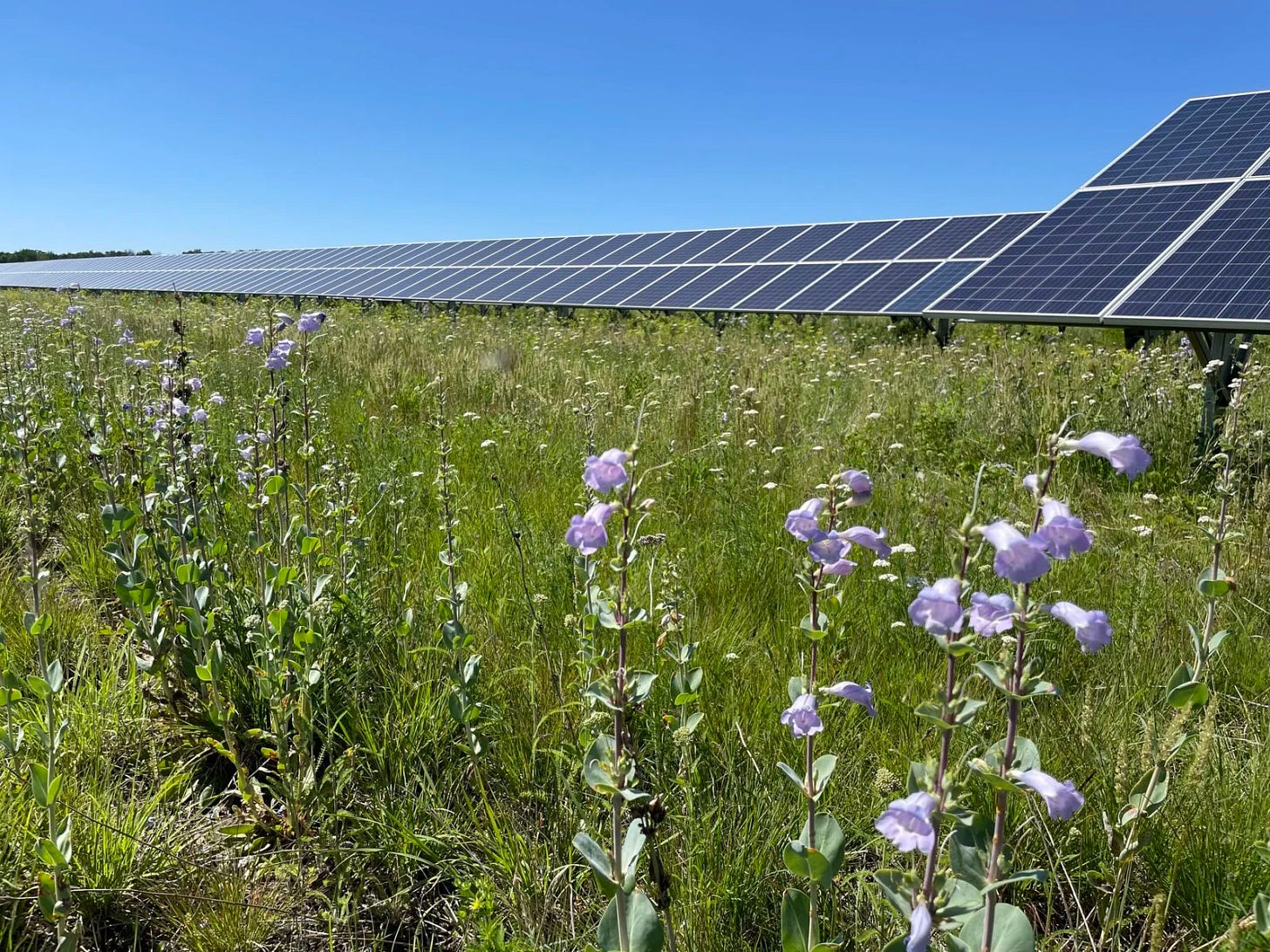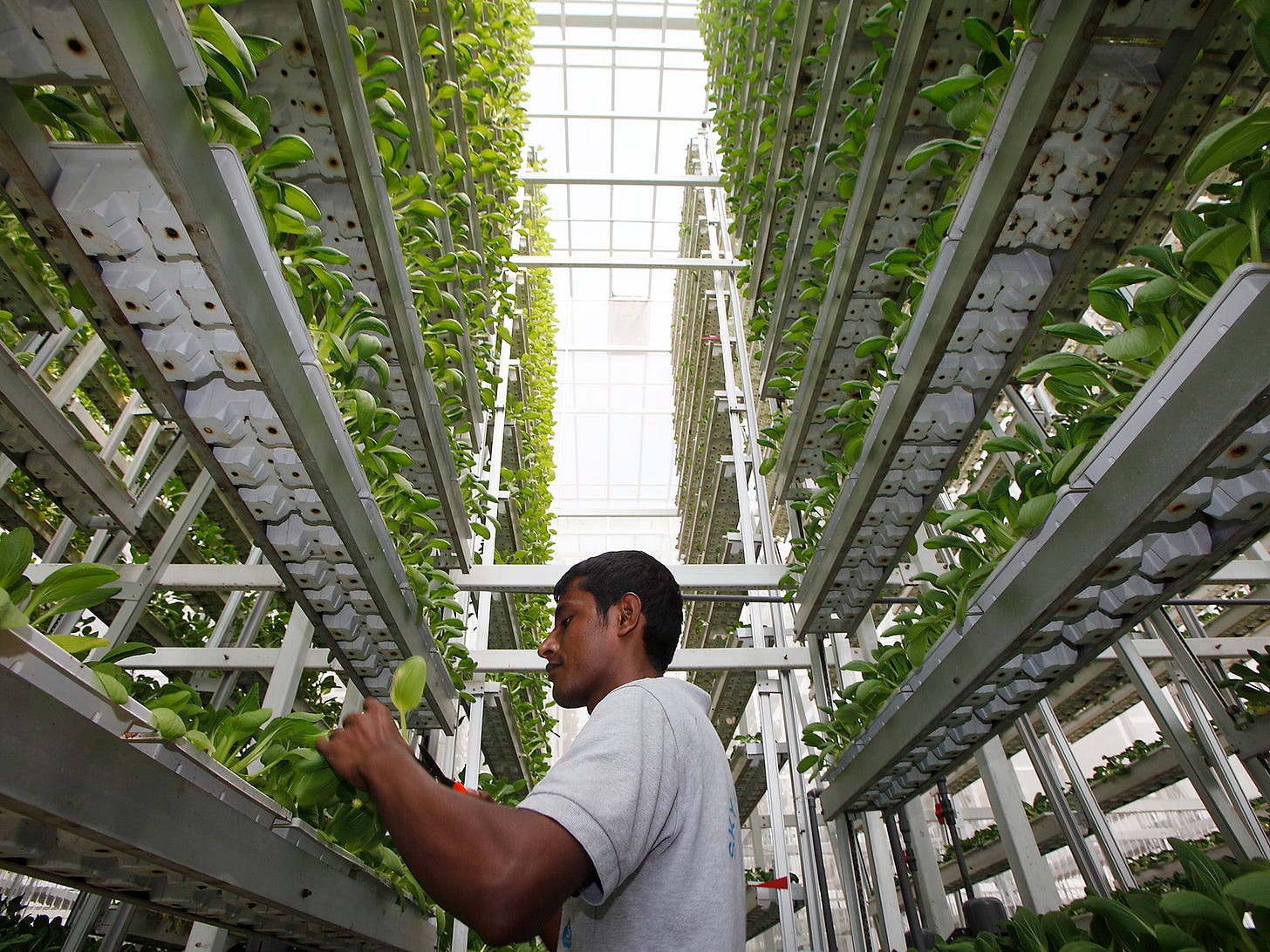Giving Farmers Choice
Allowing farmers the choice to install solar panels is good for them, the environment, and could even drive innovations in food security
Last week, in one of his first actions as Energy Secretary, Ed Miliband approved three large solar farm projects, which combined have enough capacity to power 400,000 homes. It was a long journey for these projects. Sunnica Solar Farm had to complete a 69,173 page long planning application, including 14,557 pages spent on its environmental statement.
Yet giving these projects planning approval hasn’t quieted down opposition. In actuality, Conservative politicians like Alicia Kearns and Sir Edward Leigh suggested this was part of a war on the countryside. So let’s consider how solar farms impact farmers and food security.
Imagine you’re a farmer figuring out what to do with your land. You’ve got a couple of options. You could grow a mix of conventional cereals like wheat and barley, plus oilseed rape. If it's a typical farm, using the land like this would net an average profit per acre of around £100, or up to £200 if it is a high performing farm. However, as any fan of Clarkson’s Farm would know, profits are by no means guaranteed, and there’s a lot of risk with slim margins.
An alternative option is to build a solar farm on the land. If you chose to lease the land to a solar developer you could expect up to £1000 per acre per year, guaranteed for between 25 and 40 years. This is indexed to inflation too, so it is unaffected by the swings in prices that farms regularly experience. Solar panels provide a diversified source of income for farmers, while requiring minimal input.
Farmers can even choose to continue to graze livestock alongside the solar panels. The panels provide shade for sheep, while the sheep can cut down on mowing costs. Or farmers can choose to mix the solar land with wildflowers to attract bees and other pollinators, helping to increase biodiversity. Leaving the field fallow enables the recovery of soil health, helping to heal the degradation that can occur over many years of ploughing arable land.
If we give farmers the option to do what they’d like with their land, many of them would choose the guaranteed £1,000 a year compared to a lot of hard work for £100-£200. The Vice Chairman of Somersham Parish Council in Suffolk, which objected to plans for a solar farm that would power 7,000 homes and annually save 6,000 tonnes of CO2, agrees:
”Our community understands a farmer’s motivation to receive £1,000 an acre guaranteed for 40 years rather than working very hard for around £150 an acre. We feel this may be a wise choice for the individual and not for the community.”
But is it really the role of a local parish council to dictate to a local farmer how they should be allowed to run their farm and what they should be allowed to do with their land? Especially at a time when half of Britain’s fruit and veg growers may go out of business within a year. If the local council wants to ban farmers from making a choice about how they use their land, the underpinning community reasons must be very strong.
So why might a community object to farmers being able to choose what they do with their land? The biggest reason is concerns over food security. Organisations like Net Zero Watch and CPRE have argued that building more solar farms risks using up Britain’s agricultural land.
The former Energy Secretary, Claire Coutinho, agreed with these concerns, and in May told the House of Commons that best and most versatile farmland should be reserved for growing food rather than leaving it up to the farmer’s discretion on what to do with their land. This is obviously quite a large restriction on farmers, so we’d hope that the concerns over food security are right.
Let’s look at the numbers to see if these concerns are valid and how solar panels may impact Britain’s food security.
At current efficiency levels, it takes about 6 acres of land for every MW of solar capacity, and the UK currently has 15.5 GW of total solar power capacity, ⅔ of which is ground-mounted (the sort that you may put in a field). In total, that means roughly 250 sq. km of the UK is taken up by solar panels, which is around 0.1% of the entire UK landmass.
Agricultural land currently makes up 56% of the UK landmass, so for every acre of solar farm, there are roughly 560 acres of farmland.
The Government has a target to increase solar power to 70 GW by 2035. Solar technology will improve over this time, which will allow more energy to be generated from the same amount of land. The amount of power that a single panel can generate has almost doubled in the past decade. But even if we assumed no efficiency gains, that 70 GW (still assuming ⅔ ground mounted), would take up approximately 1,133 sq. km.
That sounds like a lot, but it is still only about 0.46% of the UK’s land, and still less than 1% of farmland. Golf courses, by contrast, cover more than 1,250 sq. km, but we never hear about trade-offs between golf and food security.
Solar panels are not a meaningful threat to the UK’s food security, or even the biggest threat to Britain’s best and most versatile land. The biggest threat is climate change. According to the Department for Environment, Food, and Rural Affairs, climate change, under a medium emissions scenario, could reduce the proportion of best and most versatile arable farmland from 38.1% to 11.4%- a reduction of nearly ¾.
Solar panels would help avert the worst of this looming challenge for British farmers. But more importantly, solar panels could have a role in revolutionising how farming is done.
Driving down the cost of energy by building more clean sources of power could spark a revolution for farming. The cost of solar power fell by 87% between 2011 and 2021, and this trend is hopefully set to continue. Cheaper energy means innovative and more productive forms of farming become viable.
There’s a vertical farm in Gloucestershire, which can grow lettuce and herbs at three times the normal speed as traditional agriculture in much sunnier places like Spain or Morocco, and can stack 15 rows of plants on top of each other. But this requires a lot of energy to power the LEDs and temperature control. The energy price spike after the Russian invasion of Ukraine drove many innovative, vertical farms out of business. This included farms in Britain, Germany, and the industry leader, US based Aerofarms, which filed for bankruptcy in June 2023 because of high electricity prices.
Or there’s Thanet Earth in Kent, for example, the largest greenhouse complex in Britain. The facility currently grows 400 million tomatoes, 24 million peppers, and 30 million cucumbers a year, equal to about 10% of Britain’s entire annual production. Crops are harvested every day of the week, 52 weeks a year. The entire complex covers just 0.89 sq km of land, about half the size of Regent’s Park. But high energy costs have forced many other greenhouse growers to shut.
If we can lower the cost of energy by building more sources of power, an expansion of new and innovative ways of farming would be possible. We could improve the efficiency of farming by building new greenhouses and vertically farming land. Solar power therefore wouldn’t threaten our food security, but would in fact be vital for it. Farmers should be free to choose what is best for their business. If that means adding solar panels on some of their land, they should be allowed to do that.







Great article! As a further point Defra currently pays farmers to take land out of food production to grow winter bird feed on over 1000 sq km of productive farm land. And barely anyone has even mentioned food security impacts. Yet there is so much more concern on solar which is not only good for the environment, but also good for consumers and has little cost for government...